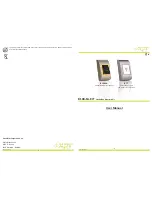
CONFIGURING 3COM 3C507 AND 3C507TP NIC
SEPT 11, 1992 [REV. JAN 22, 1993]
LAN SUPPORT TUTORIAL #3
PAGE 8
ICA Card Configuration
The 3C507 is hardcoded to use a second I/O address, I/O 100, in addition to whatever I/O
address you configure. According to 3Com, this is necessary so that the configuration
program can locate the card. What this means is that you cannot use I/O address for any of
the your other cards, so when you install the 3C507 in your server or workstation, be sure
to check all other cards' I/O addresses and change any that are set for 100. Since the ICA
card's default I/O address is 100, chances are you will have to change that address when
you install a 3C507 or 3C507TP.
It is recommended that the address be changed to one of the addresses in the table below at
the same time you add the 3Com card: you can change the ICA card's address on the Banyan
Add-A-Card screen, then shut down the server, remove the ICA card, correct the jumpers to
match the settings already entered in the Add-A-Card screen, put the card back in the
server, and reboot. (This method saves a reboot). Note that there is no jumper #8 in the
table or on the card -- this isn't a typo.
BANYAN ICA CARD: JUMPER-BLOCK SETTINGS FOR VARIOUS I/O ADDRESSES
Address
Jumper
120
140
160
180
5
down
up
down
up
6
up
down
down
up
7
up
up
up
down
9
up
up
up
up
For More Information
As many of you know, the 10BASE-T standard took several years to evolve. The standard
was finalized by the IEEE in September 1990, which is why different versions of the
specification exist at PG&E today. Draft D was one of the close-to-final versions, but some
additional changes, notably the link integrity feature, were made to the spec before
10BASE-T was complete. For more information on 10BASE-T and pre-final 10BASE-T, refer
to Hot Tips #8, 11, and 14.
Another setting that's been a source of confusion is the receive threshold (RX TH), which
determines how strong a signal from the hub must be before the transceiver will pick it up.
The U-B ASM300 concentrator card uses a lower-level signal than the 10BASE-T
requirement -- 3Vpp compared to 5Vpp -- which means that any 10BASE-T network
interface cards and TPAUs must have their receive threshold decreased in order to pickup
the lower-level signals from the ASM300. On the 3C507TP, the receive threshold is
controlled via jumper J3. Thus, to connect a 3C507TP to an ASM300 concentrator card, you
would use the "low" setting.


























